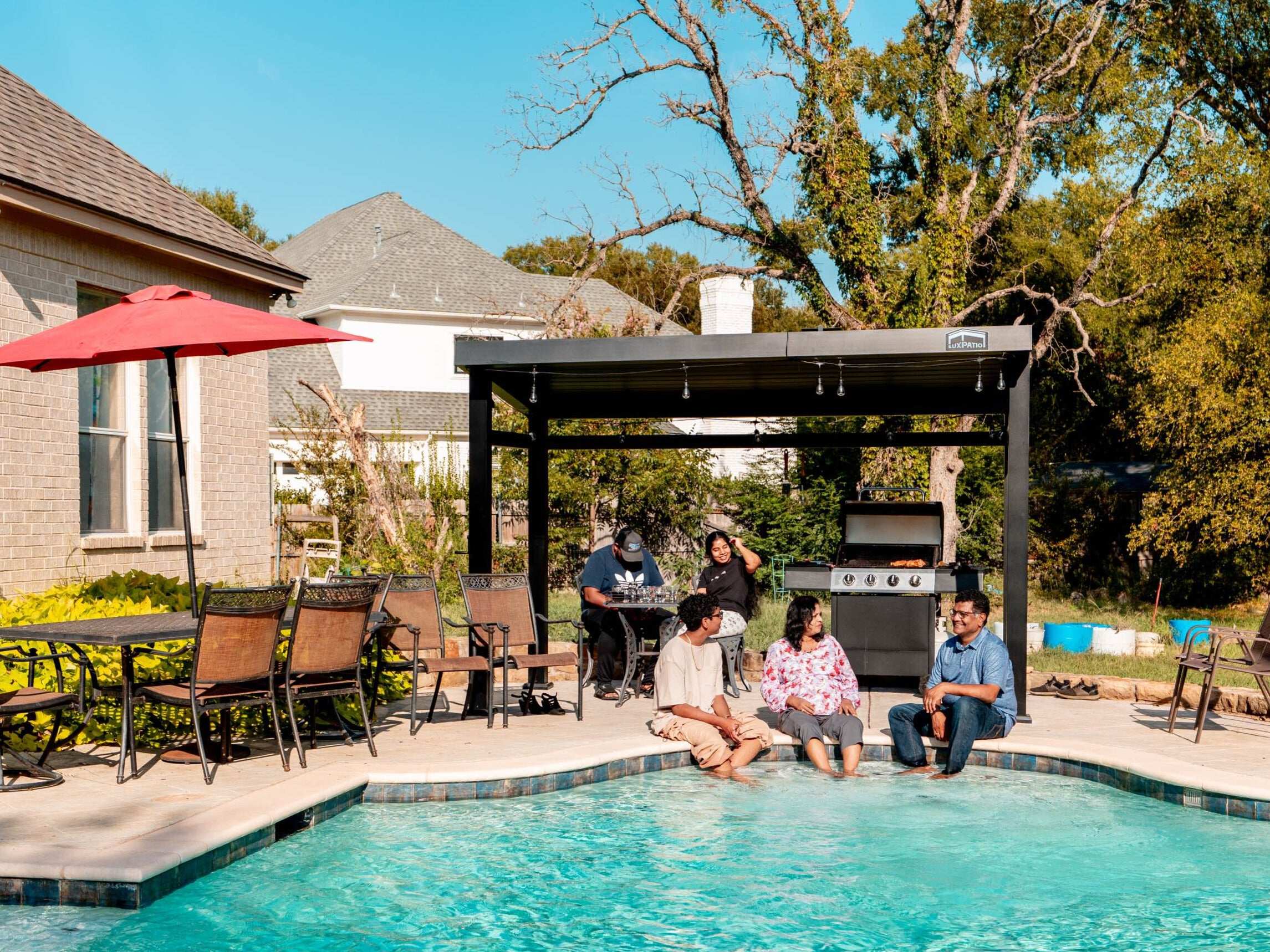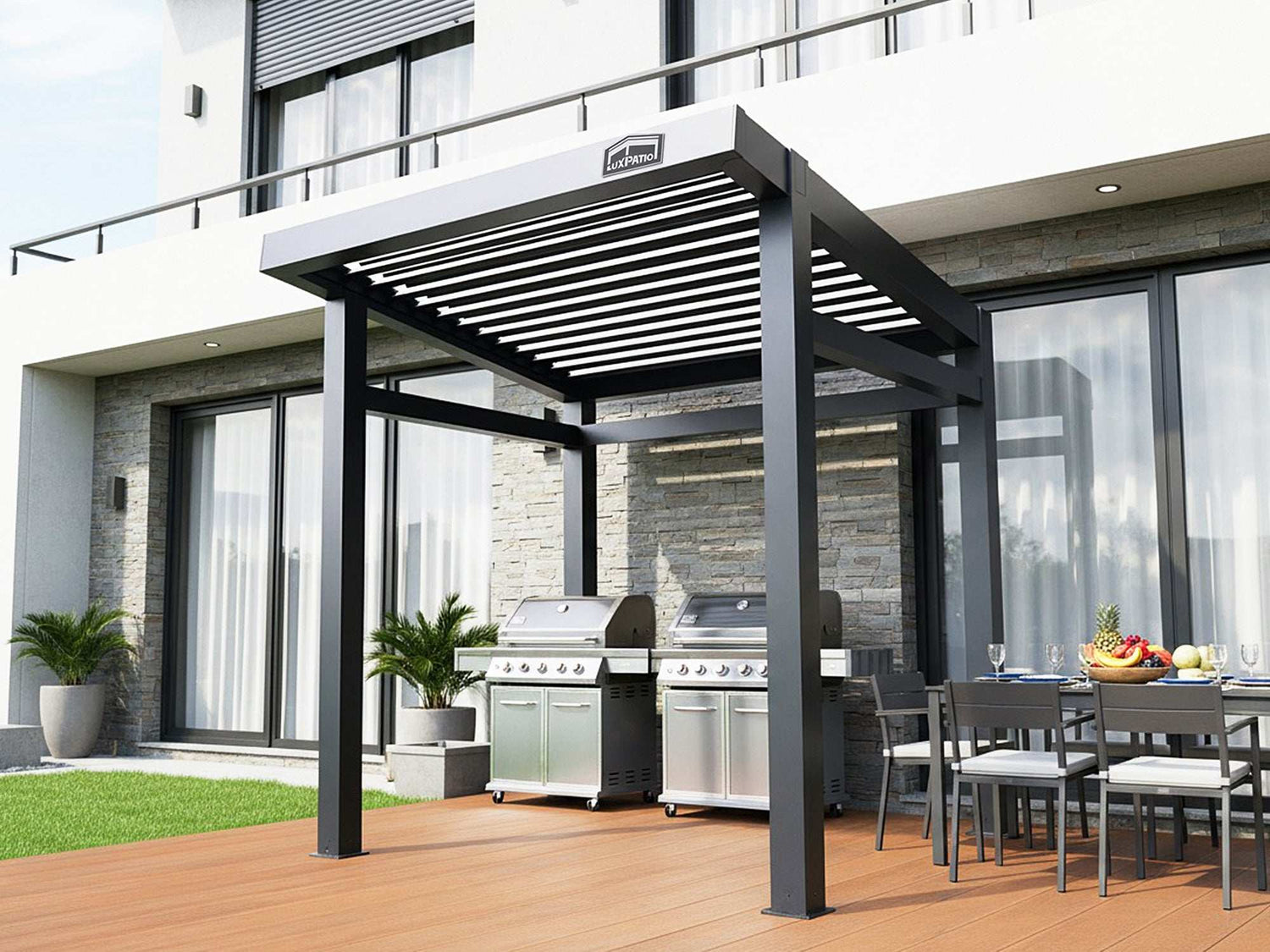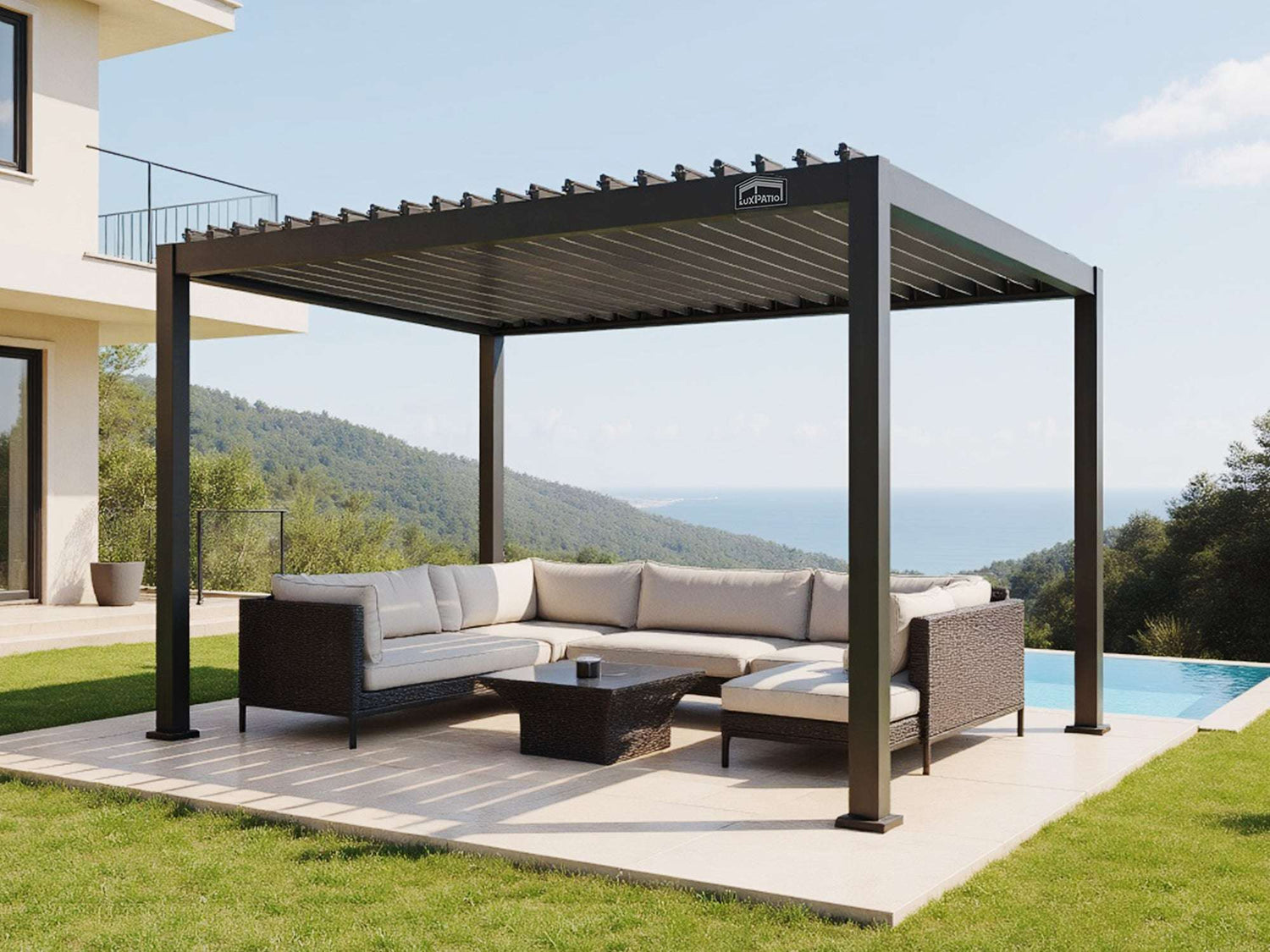A backyard pergola changes how a home feels and works. Shade, drainage, and clean lines come together when design meets careful execution. The real choice is simple to ask, yet tricky to answer. Go the DIY route or bring in a professional crew. This comparison focuses on scope, risk, and total cost so you can move forward with clarity.

Pergola Installation Fit Check: Are You Ready For DIY?
Before picking tools or booking a weekend, get honest about your site, skill set, and timeline. A pergola installation succeeds when posts land in the right places, anchors hold under wind, and water leaves the area without causing damage. The following checks help you judge readiness and avoid mid-project surprises.
Site and Permit Basics
Concrete pads, pavers, and wood decks behave differently under load. Deck installs require fastening into framing members, not just deck boards. Louvered roofs need a defined drainage path to daylight. Many cities ask for permits once you add a roof or attach posts to a deck, so confirm requirements early. Installing a pergola on an existing deck requires fastening into the structural framing, not just surface boards.
Tools and Skills Reality
Accurate layout matters. You will mark bolt patterns, drill clean holes, set posts plumb, and torque anchors to spec. Aluminum members are long and light, yet they flex. If your plan includes power for LEDs or motors, allow for safe routing and code-compliant connections before assembly begins.
Scope Boundaries That Favor DIY
Small footprints, open-roof designs, or straightforward pergola kits limit complexity. Clear, flat sites with simple anchoring conditions reduce setup time. If you and two capable helpers feel confident after reading "how to build a pergola diy," the project may fit your team.
Major Challenges of DIY Pergola Installation
Even handy homeowners bump into obstacles that do not show up on a parts list. Small layout errors creep into louver alignment. A missed drain path turns into a backsplash after the first downpour. Electrical details can affect warranty coverage. Understanding these risks improves planning and helps you decide how far to take the work yourself.
Anchoring and Leveling
Posts that lean a few millimeters multiply problems across the span. Masonry anchors need the correct diameter, embedment, and torque. Deck installs often need blocking or steel plates to transfer load into the frame. Check plumb, level, and square at each step to prevent binding louvers and wind noise.
Water Management
Integrated gutters rely on level support and consistent pitch. Too flat leads to standing water. Too steep stresses seals. Downspouts need a proven exit route that avoids siding stains and yard erosion. Plan the discharge before you tighten hardware.
Electrical and Controls
Motorized louvers and LED lighting require protected wiring and thoughtful junction locations. Use drip loops, sealed fittings, and appropriate conduit. Keep low-voltage runs separate from line power. An early talk with a licensed electrician protects both safety and warranty coverage.
Material Handling and Safety
Long beams and panels mark easily on concrete. Lifts, moving blankets, and suction cups help. If your team lacks gear for safe overhead work, reconsider the scope or schedule a professional crew for the critical set and plumb steps.

Key Benefits of Professional Pergola Installation You Can't Ignore
Professional installers bring rhythm to layout, anchoring, and finishing that DIY teams rarely match on a first build. Precision shows in quieter operation during gusts and in clean water flow during storms. You also gain certainty around code compliance and warranty eligibility, which protects value over the years, not weeks.
Precision and Speed
Experienced crews square frames, check diagonals, and lock hardware efficiently. That accuracy keeps louvers moving smoothly and seals working as designed. A job that might span a long weekend for a DIY team can wrap in hours.
Compliance and Warranty Confidence
Permits, inspections, and documentation vary by city. Crews handle submittals and site photos while following manufacturer guidance. That record supports structural and finish warranties if you ever need service.
Cleaner Integration
Electricians coordinate safe power feeds for motors and lighting. Sealants and flashings match the substrate and climate. The result looks consistent from day one and stays that way through seasons of sun and rain.
Time Back and Less Risk
You keep weekends for family time. The crew absorbs weather pivots, hidden deck conditions, and tricky anchors. Rework risk drops sharply when experienced hands lead assembly.
DIY vs Pro Pergola Cost Breakdown: Hidden Expenses Revealed [2025]
Budget conversations often start with the kit price. Real totals depend on anchors, electrical, handling, and the value of your time. The ranges below reflect common U.S. projects and help frame pergola installation cost for both paths. Expect local variation by size, features, and the labor market.
| Item | DIY Typical | Pro Typical | Notes |
| Structure or kit | $3,000 to $12,000 | $3,000 to $12,000 | Aluminum or louvered systems price by size and options |
| Anchors, adhesives, sealants | $150 to $400 | Included or $150 to $400 | Substrate and wind exposure drive selection |
| Specialty tools or rentals | $120 to $450 | Included | SDS bits, torque tools, ladders, lifts |
| Electrical materials and labor | $300 to $1,200 | $500 to $1,800 | Power feed, protection, and controls |
| Freight and on-site handling | $0 to $250 | Usually included | Lift-gate, staging, debris removal |
| Rework or error allowance | $0 to $600 | Minimal | Mis-drilled holes, scratched parts |
| Permit and inspection | $50 to $300 | $50 to $300 | Some cities run higher for complex work |
| Labor hours | Your time | Installer labor | Crews finish in hours where DIY may take days |
A final point on scope: motorized or louvered designs concentrate value in precision. Pricing sometimes appears closer once you add tool rentals, consumables, and rework to DIY totals. For aluminum pergola installation on complex sites, professional labor often protects both the finish and schedule.

The LuxPatio Difference: Free Assembly ($1,000 Value) and More
Some policies change the math. Free on-site assembly valued at one thousand dollars removes a major labor line from the budget and eliminates guesswork around set, plumbing, and anchor quality. Quick shipping promises tighten your project timeline, while long, tiered warranties cover structure, moving parts, and electrical accessories with clarity.
Free Assembly Coverage
Trained installers handle on-site assembly and anchoring within the defined scope. Accuracy at this stage drives smooth louver motion and clean drainage for years.
Fast, Predictable Delivery
A clear shipping commitment supports planning for concrete work, electricians, and landscaping. Predictability reduces idle time and keeps momentum on your project.
Built to Last
Powder-coated aluminum frames resist corrosion, integrated drainage keeps water away from the living area, and support teams stand behind the product. For louvered pergola installation, those details add up to quiet operation and stable finishes.
Professional or DIY: Which Do I Choose?
Choosing a path gets easier when you frame the decision around site conditions, feature set, and timeline. If the project stays small, the site is forgiving, and your helpers are reliable, DIY can feel rewarding and sensible. If motors, lighting, wind exposure, or deck substrates enter the plan, a professional crew shifts risk off your shoulders.
Choose DIY If These Statements Fit
- The site is flat with obvious anchor points and no hidden obstacles.
- No new power run is needed, or a safe feed already exists.
- You have the tools and two or three capable helpers for safe lifts.
- You are comfortable drilling into concrete or fastening into deck framing.
Choose Professional Installation If Any Applies
- Motorized roof, LED lighting, or controls are part of the design.
- The location sees strong winds, sits on a deck, or requires special anchors.
- Your schedule is tight, and you want one clean site visit.
- You prefer warranty clarity and documented, code-aware work.
Is Professional Pergola Installation Worth the Investment?
Yes. A thoughtful pergola installation delivers shade, comfort, and resale value for years. Simple shade frames on clear sites reward DIY teams that pass the fit check and enjoy careful work. Projects with motors, lighting, tight tolerances, or challenging substrates favor professional crews. The price gap narrows once anchors, electrical, tools, and rework are counted, and it narrows again when free assembly removes a thousand-dollar labor line. If your goal is a pergola that looks level from every angle, runs quietly in gusts, and drains cleanly in heavy rain, professional installation delivers lasting confidence.

FAQs about Pergola Installation
Q1. How do I commission a pergola after installation?
Verify each column is plumb within 2 mm and torque structural bolts per spec. Confirm frame diagonals within 3 mm. Calibrate louver travel and limit stops. Flood-test gutters with 5–10 gallons of water and photo-document results to support warranty.
Q2. What changes near coastal environments?
Choose 316 stainless fasteners and sealed bearings. Rinse salt mist every month. Apply polymer sealant or automotive wax on powder coat twice a year. Isolate dissimilar metals with nylon washers. Add dielectric grease to terminals. Inspect and re-torque hardware every six months.
Q3. How do I verify wind and snow ratings?
Request the manufacturer's engineering tables and match your site's exposure, design wind speed, and ground snow load. Submit with permit drawings if required. Follow the operating position guidance for storms and freezing conditions, and establish a roof snow management plan.
Q4. What is a practical maintenance schedule?
Quarterly: flush gutters and downspouts. Twice yearly: wash with pH-neutral soap, inspect seals, re-torque critical hardware. Annually: lubricate pivots with dry PTFE, test motor current draw, and check finish for chips. Avoid chlorine cleaners, strong solvents, or abrasive pads.
Q5. Can I integrate the pergola with a smart home?
Use dry-contact or relay modules approved for the controller. Feed from a GFCI-protected circuit. Add a Type 2 surge protector at the subpanel. Ensure reliable outdoor Wi-Fi and weatherproof junction boxes rated NEMA 3R or IP65.










